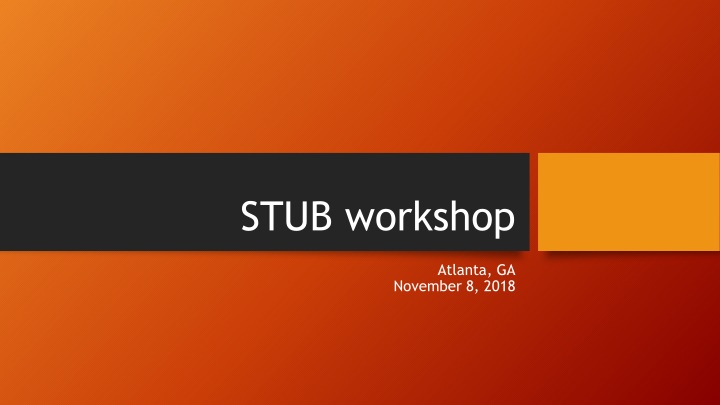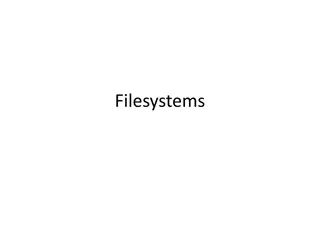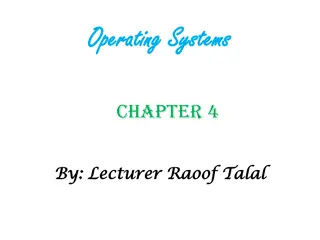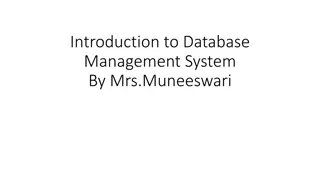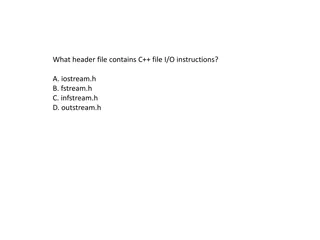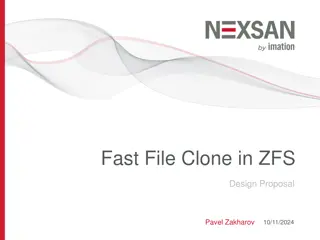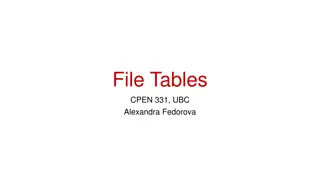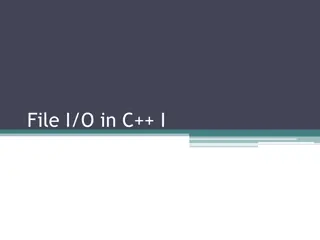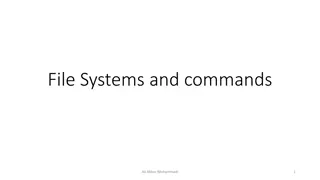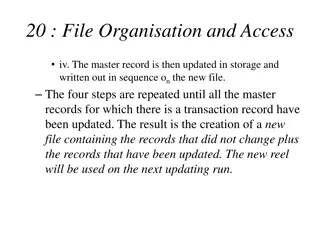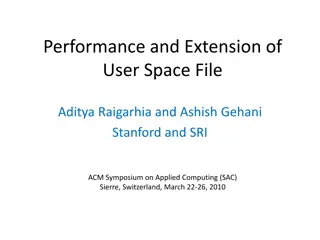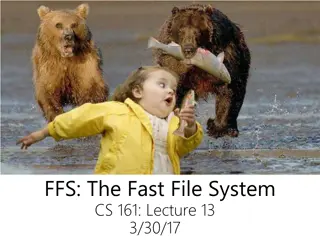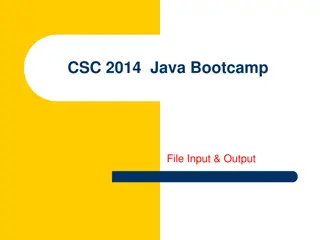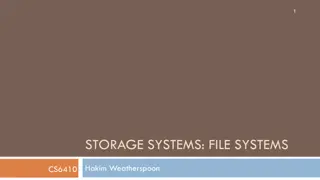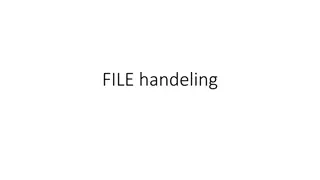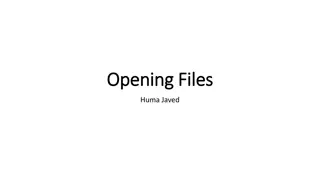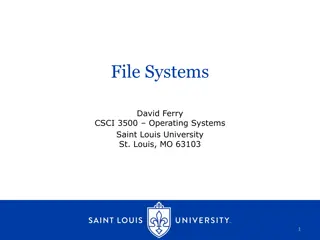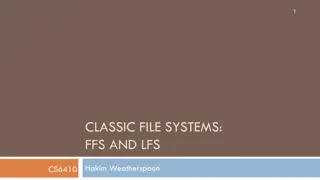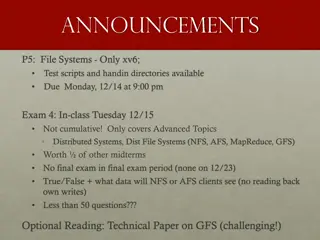Introduction to Process and File Systems Overview
This content provides a detailed exploration of process introduction and file systems, covering important concepts such as user/kernel modes, interrupts, interrupt handling, and system dispatch patterns. It delves into the structure of processes, memory organization, system transitions, and more. The images included offer visual aids to enhance understanding. Key topics include user/kernel privilege modes, interrupt vectors, system return methods, register handling, and system stack setup.
Download Presentation

Please find below an Image/Link to download the presentation.
The content on the website is provided AS IS for your information and personal use only. It may not be sold, licensed, or shared on other websites without obtaining consent from the author.If you encounter any issues during the download, it is possible that the publisher has removed the file from their server.
You are allowed to download the files provided on this website for personal or commercial use, subject to the condition that they are used lawfully. All files are the property of their respective owners.
The content on the website is provided AS IS for your information and personal use only. It may not be sold, licensed, or shared on other websites without obtaining consent from the author.
E N D
Presentation Transcript
STUB workshop Atlanta, GA November 8, 2018
Overarching workshop goals Have active and engaged discussions about the role of statistics in undergraduate biology courses Connect participants with existing materials, readings, and results Continue to launch the STUB network Reflect on ways that the STUB network can best support you
Overarching grant goals Grant from NSF s Research Coordination Network Undergraduate Biology Education grant program (2017- 2022) Initial steering committee consisting of Cal Poly SLO: Beth Chance, Elena Keeling, Soma Roy Dordt College: Jeff Ploegstra and Nathan Tintle Dutchess County Community College: Mark Condon and Barbara Dolansky Hope College: Greg Murray, Todd Swanson and Jill VanderStoep UCLA: Rob Gould and Noa Pinter-Wollman The goals of the network include: (a) the development and wide dissemination of numerous freely available modules and assessment items for teaching, (b) published peer-reviewed articles on teaching best practices and assessment results related to statistical thinking in undergraduate biology courses, (c) a long-lasting improvement in the teaching of statistical thinking in the undergraduate biology curriculum, and (d) introductory statistics courses reflecting the needs and perspective of biology (and other quantitative science) students.
Structure of workshop Mix of interdisciplinary conversations in small groups (2-3 people) and large group conversation Mix of reflecting and discussion along with hands on in-class activity/module development Facilitated by: Mark Condon (Bio), Greg Murray (Bio) and Lance Waller (Stats); As well as by Nathan Tintle (Dordt; Stats), but hopefully run by everyone Flat network goal equitable exchange of ideas
Session #1 part 1 Trends in statistics education GAISE guidelines on how to teach (2005 and 2016; endorsed by Am Stat Assoc) 1. Teach statistical thinking. Teach statistics as an investigative process of problem-solving and decision making. Give students experience with multivariable thinking. 2. Focus on conceptual understanding. 3. Integrate real data with a context and purpose. 4. Foster active learning. 5. Use technology to explore concepts and analyze data. 6. Use assessments to improve and evaluate student learning.
Session #1 part 1 Trends in statistics education Assessment results illustrating that students don t really (a) improve much pre to post-course on standardized tests of statistical thinking or (b) retain much in a typical introductory statistics course Increased computational resources for data collection and analysis Recognition of the utility of simulation to enhance student understanding of random processes Changes in K-12 education what students are learning and seeing of statistics there Big, messy data Technology not calculators, but computers Anecdotes about poor understanding missing the big picture
Simulation-based methods a potential solution Simulation-based methods Simulation For example, use coins and spinners to simulate outcomes binomial distributions Building an empirical sampling distribution Not a sampling distribution one derived/proved using mathematical and probabilistic rules Bootstrapping Re-sampling from the data with replacement to build an empirical sampling distribution to estimate standard errors Permutation tests Randomizing group allocations to the existing data to build and empirical sampling distribution if the null hypothesis is true
Simulation-based methods a potential solution Hopes of the simulation-based curriculum Intuitive Can be introduced very early in the course (e.g., week 1) Little mathematical/probabilistic scaffolding needed to help students grasp the core logic of inference Connections between tactile and computer based simulations (active learning inherent) Opportunities for spiraling introducing inferential reasoning early and going over it throughout the semester
SBI network NSF grant to Workshops on simulation-based inference Blog to coordinate discussion; resources Assessment initiative
Network/Workshop diversity Over 1000 individuals have participated in one of over 30 workshops we have offered between 2014 and 2018. Many of these same individuals participate in the assessment project and are part of a related blog/online community. In addition to the dots shown on the map above, over 50 individuals from international locations have also participated. Note: Less than 1000 dots appear visible on the graph due to cases where individuals from close geographic proximity participated (e.g., same or nearby institutions in large metro areas) or for non-US participants.
Blog and online resources http://www.isi-stats.com Applets, datasets, some free materials, some demo videos, http://www.causeweb.org/sbi Over 50 blog posts, links to other teaching resources, video archived workshops, frequently asked questions, etc.
Assessment Understand student performance Over last 48 months over 13,000 students at over 200 institutions and over 300 instructors Embedded exam questions for subset of instructors to gain information on learning trajectories (subset) Pre-post course content knowledge and attitudes Modified concept inventory based on NSF CAOS instrument SATS (attitudes assessment) Also: Retention study (subset 4 month and 1year follow-up) on longitudinal gains
Preliminary assessment results SBI curricula tend to outperform other curricula consistently across institutions (including HS), instructors, etc. (better end of course performance, better retention) Tintle et al. 2011, Tintle et al. 2012, Chance et al. 2017, Chance et al. 2018, Tintle et al. 2018, Roy et al. 2018, VanderStoep et al. 2018 Gains are reasonably consistent across student ability levels Tintle et al. 2018, Swanson et al. 2018
